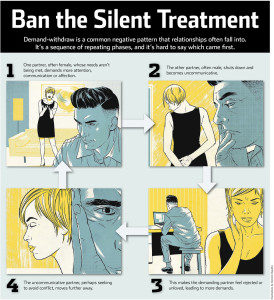
Illustration courtesy of the Wall Street Journal
At some point in their lives, most people have probably been the receiver – or the giver — of the infamous “silent treatment.” It’s generally acknowledged that this type of communication shutdown isn’t the best way to deal with a problem, but according to research by communication studies professor Paul Schrodt, it’s even more detrimental than most people may think.
Schrodt’s findings, along with those of other communication scholars across the nation, were recently the subject of the Wall Street Journal article “How and Why to Ban the Silent Treatment from Your Relationship.” (Read the article here).
The silent treatment is part of what researchers call the “demand-withdrawal” pattern. According to the WSJ article, “It happens when one partner repeatedly approaches the other with a request, whether asking for attention or change—or giving criticism—and is met with avoidance or silence.”
Schrodt and colleagues conducted an analysis of 74 studies involving more than 14,000 participants. The findings, which were published in the March 2014 Communication Monographs, showed that the demand-withdraw pattern is one of the most damaging types of relationship conflict. It’s also one of the hardest patterns to break.
According to Schrodt, who was lead researcher in the analysis, both partners have a hand in the silent treatment — yet each blames the other. The person making the demands feels shut out and that his or her emotional needs are being neglected; conversely, the person withdrawing feels nagged.
But there is hope. Schrodt advises that becoming aware of the pattern is the first step in breaking the demand-withdrawal cycle. Each partner should consider his or her role in the cycle and the other person’s viewpoint, then talk it out.
At TCU, Schrodt teaches courses on interpersonal communication, family communication and conflict resolution. An avid researcher, his work has published in more than 60 articles in leading communication journals.
